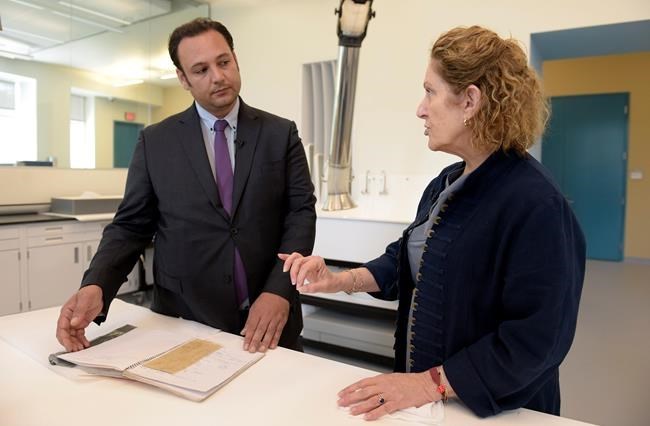
Jane Klinger, right, chief conservator for the United States Holocaust Memorial Museum, talks with Mansour al-Omari, left, a Syrian human-rights activist documenting cases of people who have disappeared under President Bashar Assad's government, who shows scraps of fabric with the names of fellow inmates he is presenting to the U.S. Holocaust Memorial Museum for preservation at the conservation center, Tuesday, Aug. 8, 2017, in Bowie, Md. (AP Photo/Susan Walsh)
Republished August 08, 2017 - 3:05 PM
Original Publication Date August 08, 2017 - 11:31 AM
BOWIE, Md. - A Syrian human-rights activist presented the U.S. Holocaust Memorial Museum's research and preservation centre on Tuesday with scraps of cloth that fellow prisoners had written their names on while using a chicken bone as a quill and blood from their own gums as ink.
Mansour Omari, who spent nearly a year in captivity, said he hoped museum officials would preserve the 82 names as evidence and, through displaying the items, raise awareness among visitors to the Washington museum about the Syrian civil war, now in its seventh year. Omari said he was tortured, blindfolded and kept in a crowded underground detention centre during part of his incarceration.
"I want the visitors to know that these names, many of them, are still now under ground, and some of them are dying," he said, after handing the scraps of fabric and the notebook he kept them in to preservationists.
Omari was working with the Syrian Center for Media and Freedom of Expression to document cases of people who have disappeared under President Bashar Assad's government when his office was raided in 2012. He said he decided to continue his work while detained and teamed up with others to document the names of those around them. They used a chicken bone to write, Omari said, and they used their own bleeding gums as an inkwell, after tomato soup didn't work.
"I was documenting the names of the people, and that's why I was arrested, but part of the reason that led me to decide to document the names in this way is a challenge to the government — that no matter what you did, even if you put us underground, we were still working on what we believe in, and you will never conquer," Omari, who is 37 and now lives in Sweden, said.
Omari said he ended up smuggling out the cloth scraps — hiding them in a shirt — because he was the first of several detainees he was working with to be released. He then sought out relatives of the people he had met. Of the 82, Omari said he has confirmed what has happened to about 10 per cent of them. Almost half have died, and the other half are either still in prison or have been freed, he said.
Cameron Hudson, director of the museum's Simon Skjodt Center for the Prevention of Genocide, said a portion of the museum contains exhibits of contemporary mass atrocities.
"For the past two or three years, we've had an exhibit on Syria and the conflict going on in Syria, and trying to tell that story," Hudson said. "So, this story and his cloths will go into that exhibit in a few months, once they've been preserved."
Syria's civil war has killed more than 400,000 people. More than 11 million people, nearly half of Syria's population, have been driven from their homes by war since 2011, including 5 million who fled abroad as refugees.
News from © The Associated Press, 2017